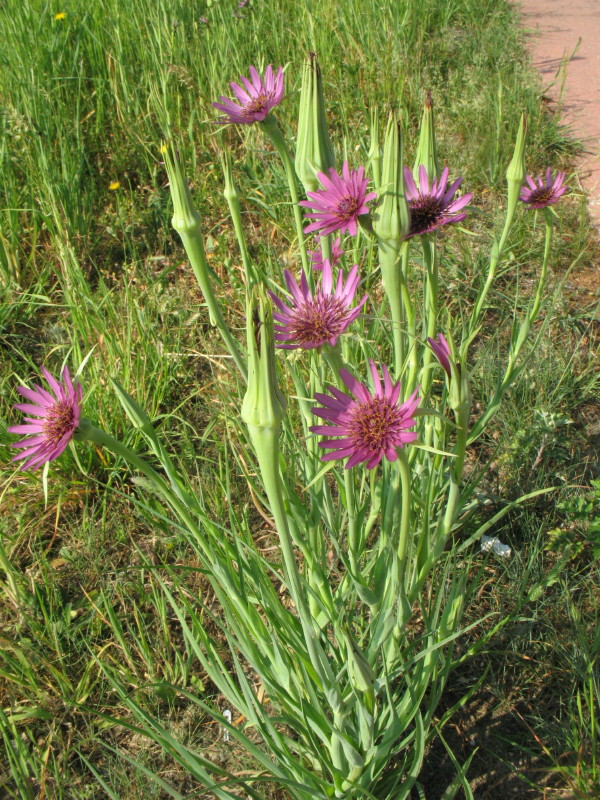Tragopogon porrifolius L. (incl. T. eriospermus Ten., T. australis Jord.) (C- and E-Medit.) – A rare and decreasing, formerly naturalized alien. Known at least since 1813 (Durand 1899). At that time more or less widespread on canal and river banks in coastal areas in the 19th century, mostly in West-Vlaanderen, but also around Antwerpen. In the past decades still regularly seen in these areas (Brugge, Oostende, Zeebrugge, etc.) but often ephemeral. A more or less stable population persists in Knokke (Burkeldijk). Elsewhere in Belgium occasionally seen, usually ephemeral but sometimes locally more or less temporarily persisting or naturalized (for instance between 1894 and 1931 near Lambermont). An up-to-date overview of Belgian records is available here: http://waarnemingen.be/soort/view/7559.
Tragopogon porrifolius was formerly sometimes cultivated for its edible roots (less so as an ornamental) which probably largely explains its occurrence as an alien in Belgium. This probably no longer holds true.
Tragopogon porrifolius is somewhat variable and its taxonomy is insufficiently known. Two (or more) more or less distinct subspecies are often separated and both occur as aliens outside their native European range (Sell & Murrell 2006): subsp. porrifolius with ligules about as long as the involucral bracts and subsp. australis (Jord.) Nyman with ligules about ½ as long as the involucral bracts. The exact identity of the Belgian collections has not been studied so far but both surely have been recorded, also in recent times. Molecular data have shown that T. porrifolius is polyphyletic (Mavrodiev & al. 2007). The cultivated form corresponds with subsp. porrifolius (T. eriospermus according to Tison & de Foucault 2014), whereas subsp. australis (and subsp. cupani (Guss. ex DC.) I.B.K. Richardson) appear in a clade well apart from subsp. porrifolius. Both may merit a higher taxonomic rank. Pending further studies in this account T. porrifolius is maintained in its traditional, broad sense.
A hybrid with native Tragopogon pratensis (T. xmirabilis Rouy) has been recorded among its parents, for instance in Gullegem (Heylen 2000; see also Holverda & al. 2009). Such plants have purplish ligules with a yellow base and are (nearly) sterile. Czech plants of supposed T. xmirabilis turned out to be fertile and seem to represent a distinct species (Mavrodiev & al. 2013). The American T. mirus Ownbey is also very similar (bicolored ligules) but is perfectly fertile and leaf faces are initially tomentulose to floccose (Soltis 2006).
 |
 |
 |
 |
Selected literature:
Bobowicz M.A. (1984) Species variability in Tragopogon L. genus (Asteraceae) in Poland. 1. Interspecific variability of Tragopogon dubius Scop., Tragopogon pratensis L., Tragopogon orientalis L., Tragopogon heterospermus (Schweigg.) C. Rgl. and Tragopogon porrifolius L. Bull. Soc. Amis Sci. Lett. Poznań, ser. D – biol. 24: 109-121.
Clements D.R., Upadhyaya M.K. & Bos S.J. (1999) The biology of Canadian weeds: 110. Tragopogon dubius Scop., Tragopogon pratensis L. and Tragopogon porrifolius L. Canad. J. Pl. Sci. 79: 153-163. [available online at: http://pubs.aic.ca/doi/pdf/10.4141/P98-007]
Durand T. (1899) Phanérogames. In: De Wildeman E. & Durand T., Prodrome de la flore belge. A. Castaigne Editeur, Bruxelles: 1112 p.
Heylen O. (2000) De bloemenkoning onder ons: Tragopogon x mirabilis. De Wielewaal 66: 216-217.
Holverda W., van Moorsel R. & Duistermaat L. (2009) Nieuwe vondsten van zeldzame planten in 2005, 2006 en ten dele 2007. Gorteria 34: 1-40.
Mavrodiev E.V., Krahulec F., Soltis D.E. & Soltis P.S. (2013) A cryptic taxon rather than a hybrid species of Tragopogon (Asteraceae) from the Czech Republic. Kew Bull. 68(1): 1-9. [available online at: https://www.researchgate.net/publication/257776517_A_cryptic_taxon_rather_than_a_hybrid_species_of_Tragopogon_%28Asteraceae%29_from_the_Czech_Republic]
Mavrodiev E.V., Soltis P.S., Gitzendanner M.A., Baldini R.M. & Soltis D.E. (2007) Polyphyly of Tragopogon porrifolius L asteraceae, a European native with intercontinental disjuncts. International Journal of Plant Sciences 168(6): 889-904.
Sell P. & Murrell G. (2006) Flora of Great Britain and Ireland. Vol. 4 Campanulaceae – Asteraceae. Cambridge University Press, Cambridge: XXVIII + 624 p.
Soltis P.S. (2006) Tragopogon. In: Flora of North America Editorial Committee (eds.), Flora of North America, vol. 19. Oxford University Press, New York-Oxford: 303-306. [available online at: http://www.efloras.org/florataxon.aspx?flora_id=1&taxon_id=133279]
Tison J.-M. & de Foucault B. (coord.) 2014) Flora Gallica. Flore de France. Editions Biotope, Mèze : xx + 1196 p.

